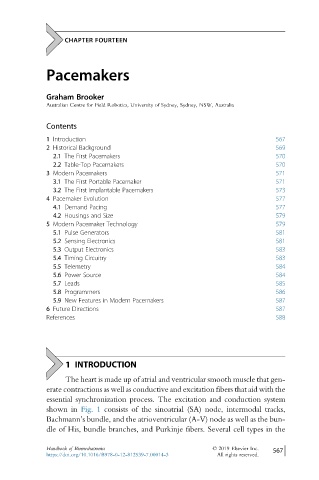Page 574 - Handbook of Biomechatronics
P. 574
CHAPTER FOURTEEN
Pacemakers
Graham Brooker
Australian Centre for Field Robotics, University of Sydney, Sydney, NSW, Australia
Contents
1 Introduction 567
2 Historical Background 569
2.1 The First Pacemakers 570
2.2 Table-Top Pacemakers 570
3 Modern Pacemakers 571
3.1 The First Portable Pacemaker 571
3.2 The First Implantable Pacemakers 573
4 Pacemaker Evolution 577
4.1 Demand Pacing 577
4.2 Housings and Size 579
5 Modern Pacemaker Technology 579
5.1 Pulse Generators 581
5.2 Sensing Electronics 581
5.3 Output Electronics 583
5.4 Timing Circuitry 583
5.5 Telemetry 584
5.6 Power Source 584
5.7 Leads 585
5.8 Programmers 586
5.9 New Features in Modern Pacemakers 587
6 Future Directions 587
References 588
1 INTRODUCTION
The heart is made up of atrial and ventricular smooth muscle that gen-
erate contractions as well as conductive and excitation fibers that aid with the
essential synchronization process. The excitation and conduction system
shown in Fig. 1 consists of the sinoatrial (SA) node, intermodal tracks,
Bachmann’s bundle, and the atrioventricular (A-V) node as well as the bun-
dle of His, bundle branches, and Purkinje fibers. Several cell types in the
Handbook of Biomechatronics © 2019 Elsevier Inc. 567
https://doi.org/10.1016/B978-0-12-812539-7.00014-3 All rights reserved.

